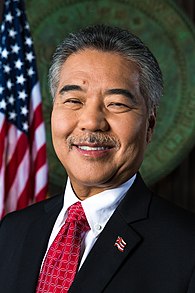List of Governors of Hawaii
| Governor of Hawaii | |
|---|---|
| Residence | Washington Place |
| Term length | Four years, maximum of two terms consecutively: eligible again after 4-year respite. |
| Inaugural holder | William F. Quinn |
| Formation | August 21, 1959 |
| Deputy | Shan S. Tsutsui |
| Salary | $117,312 (2013) |
| Website | hawaii.gov/gov |
The Governor of the State of Hawaii is the head of the executive branch of Hawaii's state government, and commander-in-chief of the state's military forces. The governor has a duty to enforce state laws; the power to either approve or veto bills passed by the Hawaii Legislature; the power to convene the legislature; and the power to grant pardons, except in cases of treason and impeachment.
Of the seven governors of the state, two have been elected to three terms, three have been elected to two terms, and two have been elected to one term. No state governor has yet resigned or died in office, nor did any territorial governor die in office. George Ariyoshi was the first Asian American to be governor of any U.S. state. The current governor is David Ige, who took office on December 1, 2014.
The Republic of Hawaii was annexed by the United States in 1898. It was organized into Hawaii Territory in 1900, and admitted as a state in 1959. The Republic had only one president, Sanford B. Dole, who later was the first territorial governor. Between 1893 and 1894, Hawaii was under the Provisional Government of Hawaii, with no formal leader. Before 1893, Hawaii was a monarchy; see list of monarchs of Hawaii.
Hawaii Territory was organized on June 14, 1900, remaining a territory for 59 years. Twelve people served as territorial governor, appointed by the President of the United States.
...
Wikipedia

